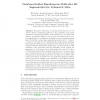104
click to vote
ECCV
2006
Springer
16 years 2 months ago
2006
Springer
We address the problem of segmenting an image sequence into rigidly moving 3D objects. An elegant solution to this problem is the multibody factorization approach in which the mea...
ECCV
2006
Springer
16 years 2 months ago
2006
Springer
136
Voted
ECCV
2006
Springer
16 years 2 months ago
2006
Springer
Abstract. Automatic delineation of anatomical structures in 3-D volumetric data is a challenging task due to the complexity of the object appearance as well as the quantity of info...
115
click to vote
ECCV
2006
Springer
16 years 2 months ago
2006
Springer
i Integration of surface normal vectors is a vital component in many shape reconstruction algorithms that require integrating surface normals to produce their final outputs, the de...
82
Voted
ECCV
2006
Springer
16 years 2 months ago
2006
Springer
For many medical segmentation tasks, the contrast along most of the boundary of the target object is high, allowing simple thresholding or region growing approaches to provide near...
109
Voted
ECCV
2006
Springer
16 years 2 months ago
2006
Springer
Abstract. In this paper we introduce a principled approach to modeling the image brightness constraint for optical flow algorithms. Using a simple noise model, we derive a probabil...
102
Voted
ECCV
2006
Springer
16 years 2 months ago
2006
Springer
Since the precise modeling of reflection is a difficult task, most feature points trackers assume that objects are lambertian and that no lighting change occurs. To some extent, a ...
107
click to vote
ECCV
2006
Springer
16 years 2 months ago
2006
Springer
Abstract. The estimation of the epipolar geometry is especially difficult where the putative correspondences include a low percentage of inlier correspondences and/or a large subse...
106
click to vote
ECCV
2006
Springer
16 years 2 months ago
2006
Springer
Non-negative tensor factorization (NTF) has recently been proposed as sparse and efficient image representation (Welling and Weber, Patt. Rec. Let., 2001). Until now, sparsity of t...
108
Voted
ECCV
2006
Springer
16 years 2 months ago
2006
Springer
Abstract. Bottom-up approaches, which rely mainly on continuity principles, are often insufficient to form accurate segments in natural images. In order to improve performance, rec...



